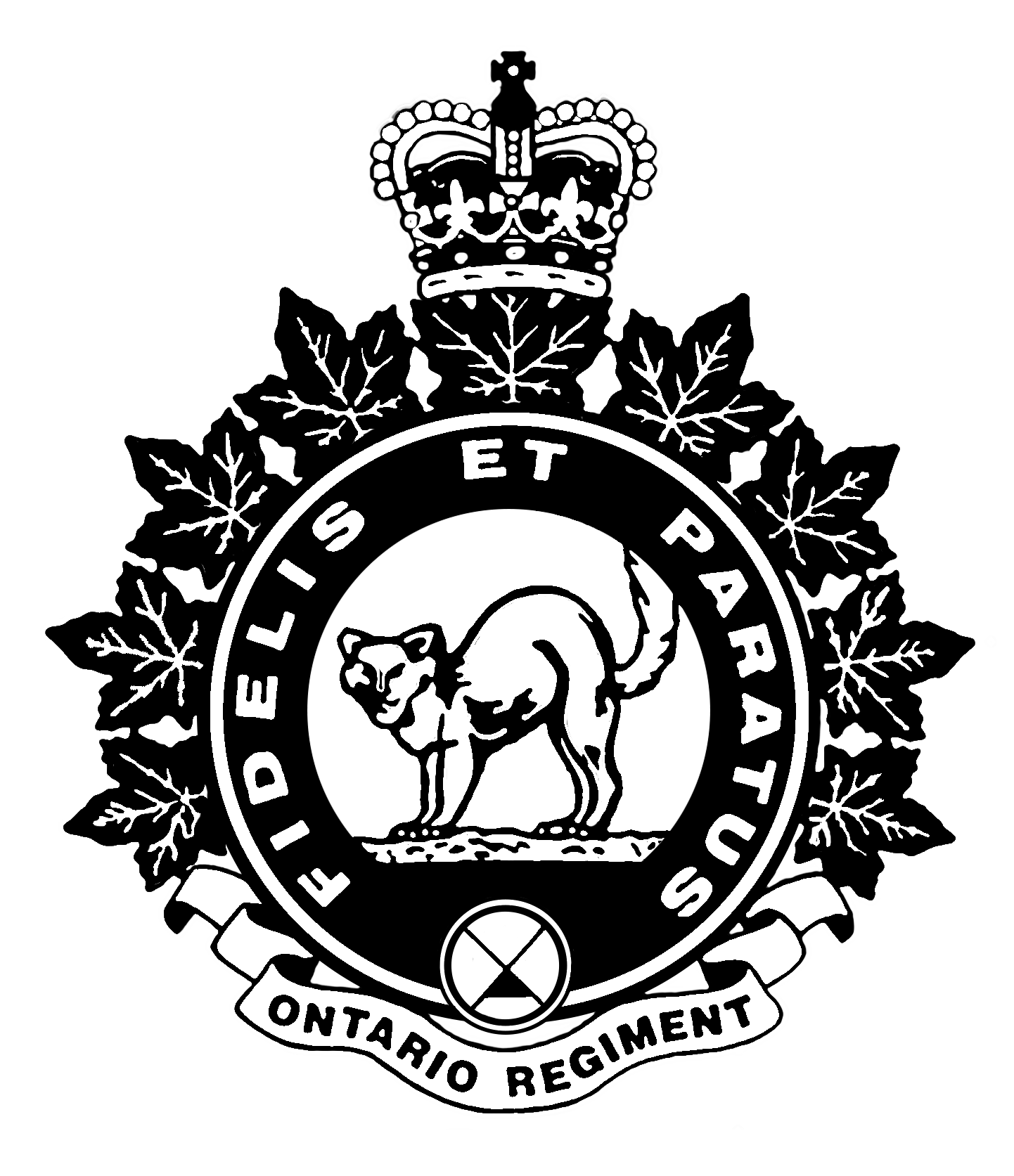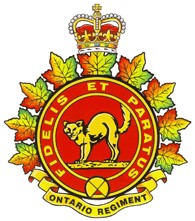For the Ontario Regiment, the Second World War began with a terse, three-word telegram sent to commanding officer Lieutenant-Colonel E. Pearson at 16:15 hours on 1 September 1939. The telegram simply stated:
Mobilize. Stop. Ack.

Within four hours, Lieutenant-Colonel Pearson had gathered the Regiment’s officers to discuss the mobilization plans. Regimental Sergeant-Major H. Davies and Sergeant W. McNeil were dispatched to the headquarters of Military District 2 in Toronto to receive detailed orders and forms.
The mobilization was a surprise to no one. The last days of August saw tensions increasing in Europe amid war preparations. Hitler’s eyes were on Poland. Britain had stated that they would honour their treaty to defend Poland in case of invasion. German air and ground forces attacked Poland on the morning of 1 September, leading to the mobilization order later that day for the Ontario Regiment and several other regiments of the Canadian Militia.
The Ontarios have always taken pride that they were mobilized with the first group of the Non-Permanent Active Militia. Britain did not declare war for two more days and Canada itself did not declare until 10 September. The Ontario Regiment was initially assigned to the 2nd Canadian Division.
Mobilization activities kicked off on the morning of 2 September with the creation of the medical board and the establishment of recruiting centres throughout Ontario County in Oshawa, Whitby, Port Perry, Cannington and Uxbridge. Both of these actions were fundamental to bringing the Regiment up to its authorized war-time strength. Captain Dr. W.S. Millman was named the president of the medical board with Dr. H.M. MacDonald and Dr. A.F. MacKay as members. Major J.A.B. Mitchell was appointed Unit Recruiting Officer and provided a staff to assist him.
The recruiting committee locations were commanded as follows:
Oshawa: Captain L.W. Currell, Captain S.L. Wellwood, Lieutenant H.P. Schell, Lieutenant M.C. Finley, Lieutenant M. Stroud, Lieutenant E. McEwen, Lieutenant R.J. Donabie
Whitby: Captain R.R. Insole
Port Perry: Major A.L. Tosland
Uxbridge: Lieutenant D. Holliday
Cannington: K. McDiarmid
Other key Regimental posts were named in the next few days: Captain J.H. Perry was the Paymaster and Captain J.G. Geikie was the Quartermaster.
On 4 September, the old Williams Piano Factory in downtown Oshawa was secured for use as a barracks. This facility will be the focus of next month’s article.
The medical board was initially tasked with giving medical examinations to all the current members of the Regiment to determine suitability for overseas service. Many were veterans of the First World War and were deemed too old. Others were declared unfit for other medical reasons. Recruiting was limited to men between the ages of 18 and 45, in good physical condition and with fewer than three dependents (including a wife). This last criterion eliminated more of the pre-war Ontarios. Medical examinations were conducted at the Oshawa Armoury for the local recruits and at the Whitby Armoury for those from Whitby and the northern communities of the County.
Recruiting was limited to whoever offered themselves at the Oshawa Armoury for the first few days. Beginning on 11 September recruiting parties were sent to Pickering, Brooklin, Uxbridge and Beaverton on successive days. The Regimental band and the bugle band were employed for recruiting activities.
By 4 September, there were 22 other ranks fully signed up for active service. Each day the medical board passed more men and the Regiment grew to 245 members by mid-September. As this was far under its required strength, the Ontarios were authorized to recruit from Toronto beginning on 18 September. Recruiting teams were sent to Fort York Armoury and University Avenue Armoury. The Toronto regiments were already full and there was a surplus of eager men looking for a unit to join. The Ontarios found immediate success in securing recruits.
John Richardson (later a Captain) was living in Weston and tried to join the Toronto Scottish Regiment but found that it was at full strength. He and many other men were told to come back the next day because officers from the Ontario Regiment would be there. John and several others signed up on the spot. They were told to go home, get their affairs in order and they would be contacted. John recalled that the group all had the same opinion, “To hell with that nonsense, if you want us, take us now”. A large group of them took the train to Oshawa that evening.
A group of 80 arrived in Oshawa on the night of 18 September. Other batches arrived over the next few days. On 22 September the final draft of approximately 150 recruits from Toronto arrived at the Oshawa C.N.R. station. They were met by the Regimental band and the majority of the Regiment’s members. The whole group marched to the barracks.
The Regiment stood at 594 members, all ranks, and general recruiting was halted. The remaining vacancies were reserved for specialists. Prior to the war, the Regiment stood at 250 members and about 100 of these were accepted for active service. However, uniforms and equipment did not appear with the mobilization and declaration of war. The Regiment’s supply of uniforms was depleted by 5 September. The original members of the Regiment had their prewar uniforms but new members were initially only issued an armband.
As the new men passed their physicals, they immediately began elementary training. It was difficult to keep the training program organized because different groups were at different stages. Much of the focus in the first few days was on physical fitness. With the Regiment at full strength, the training took on a more cohesive form and formally began on 25 September. Basic training was conducted under the direction of the qualified instructors from the pre-war Regiment. Major J.A. Mitchell, Captain M.P. Johnston and Captain C.R. Butt were placed in command of the training program. Staff Sergeant R.J. Hider arrived from the Canadian Armoured Fighting Vehicles School at Camp Borden to assist with the Regiment’s training.
There was time for non-military activities in that first month. The first Regimental church service was held on 10 September at Holy Trinity Church. Major Reverend F.C. Jarrett, the Regiment’s chaplain, led the service. The soldiers attended a movie at the Regent Theatre on 25 September.
The Ontario Regiment completed its first month of active service with a pay parade on 30 September and many members were granted weekend leave. The wartime Regiment was established but a lot of work still lay ahead for the Ontarios.


